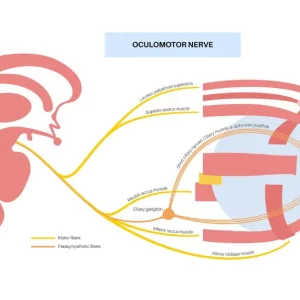Individuals may utilize an intrathecal baclofen pump to treat spasticity after a neurological injury. While this method of treatment can provide long-term spasticity relief, it is important to understand the maintenance requirements and potential complications associated with using an intrathecal baclofen pump.
Although there are many benefits of using an intrathecal baclofen pump, there are less invasive treatments available. It is generally recommended to consider more conservative treatment options before committing to a baclofen pump implantation surgery.
To help individuals weigh the pros and cons of intrathecal baclofen pumps, this article will outline how baclofen works and describe the benefits and drawbacks of the treatment. Evidence regarding the efficacy of intrathecal baclofen pump use will also be discussed.
Please use the links below to jump directly to any section.
- How baclofen works
- What are the benefits of using an intrathecal baclofen pump?
- Baclofen pump side effects & complications
- Alternative spasticity treatments
- Research regarding intrathecal baclofen pumps
How Does Baclofen Work?
Following a neurological injury such as a stroke, individuals may develop spasticity. This is a condition characterized by involuntary muscle contractions resulting from disrupted communication between the central nervous system and muscles. Without proper management, spasticity can significantly restrict mobility and cause pain. Therefore, doctors often prescribe a muscle relaxant called baclofen to provide spasticity relief.
Baclofen works by binding to the GABA receptors in the brain and spinal cord. This inhibits the release of excitatory neurotransmitters that cause muscle contractions. As a result, the muscles are less hypersensitive to stimulation, which can help improve range of motion, reduce energy expenditure, and make it easier for individuals to participate in rehabilitative therapies.
Baclofen is ideal for treating spasticity caused by neurological injuries such as:
It can be taken orally (in pill form) or administered directly to the fluid surrounding the spinal cord via an intrathecal baclofen pump. While oral baclofen can effectively reduce spasticity, its effects typically only last a few hours and it must be taken several times per day.
Additionally, when baclofen is taken orally, it can only cross the blood-brain barrier to enter the central nervous system in small amounts. As a result, it must be used in high doses to provide therapeutic relief, which increases the risk of adverse side effects. On the other hand, baclofen administered using an intrathecal baclofen pump bypasses the blood-brain barrier and is immediately available to be used.
What are the Benefits of Using an Intrathecal Baclofen Pump?
An intrathecal baclofen pump provides a continuous source of baclofen for individuals whose spasticity does not respond to oral baclofen or for those who experience severe side effects from oral baclofen. The pump must be surgically implanted under the skin of the abdomen. Baclofen is stored and distributed from the pump to the fluid surrounding the spinal cord through a catheter.
Because the intrathecal baclofen pump allows the drug to be administered directly to the central nervous system, it can effectively relieve spasticity in smaller doses than oral baclofen, thus reducing the risk of side effects.
Additionally, intrathecal baclofen pumps can be programmable, allowing physicians to adjust the dosage and rate of distribution from an external device. As a result, the dosage can be changed as often as necessary to ensure individuals are receiving the ideal amount of baclofen to manage various severities of spasticity.
To determine if the implantation of an intrathecal baclofen pump is appropriate, a test dose should be administered before implantation. For many, intrathecal baclofen pump therapy is effective in treating spasticity and can be a viable long-term treatment. However, some individuals do not respond to the treatment, or don’t have significant enough improvements to justify the procedure.
Intrathecal Baclofen Pump Side Effects & Complications
Intrathecal baclofen therapy was introduced to minimize to side effects of oral baclofen. Between 25-75% of patients experience adverse side effects from oral baclofen, including:
- Muscle weakness
- Abnormal sensation
- Drowsiness
- Nausea
Because of the smaller dosage, the risk of side effects is substantially lower among those using an intrathecal baclofen pump. However, complications may still occur. These are frequently attributed to malfunction of the implant, which can lead to inappropriate dosing.
Potential complications that may arise when using an intrathecal baclofen pump include:
- No/low drug supply
- Mechanical failure of the pump
- Battery failure
- Catheter kinks or fractures
- Disconnection of the catheter from the pump
- Migration of the catheter
- Refill error
Regular maintenance, including refilling the pump every few months and replacing its battery every 5-7 years, is essential to lessen the likelihood of malfunctioning. Regardless of the mode of baclofen administration used, sudden dosage changes are not recommended. If discontinuing baclofen use, gradual weaning is key to prevent withdrawal symptoms, such as seizures and hallucinations.
While there are many benefits of using an intrathecal baclofen pump, it is important to consider potential complications as well. Before committing to baclofen pump implantation surgery, it may be worth trying less invasive spasticity treatments.
Alternative Spasticity Treatments
Spasticity occurs when damage to the brain and/or spinal cord disrupts the transmission of messages between the central nervous system and muscles, leaving the muscles hyperactive and contracted. While baclofen can temporarily relieve high muscle tone, it does not directly address the neurological damage. Therefore, when individuals stop using baclofen, spasticity will return. Directly addressing the neurological damage can result in more permanent spasticity relief.
To do so, individuals must activate a process called neuroplasticity. This process allows the central nervous system to make adaptive changes by rewiring its neural circuitry. By activating neuroplasticity, it is possible for functions affected by neurological injury to be reorganized to areas unaffected by damage. This creates the potential for communication between the brain and muscles to be restored, resulting in permanent spasticity relief.
The most effective way to promote neuroplasticity is through highly repetitive, task-specific practice. A physical or occupational therapist can help assess which muscles are affected by spasticity and create a personalized exercise regimen to target these areas. Continuously practicing targeted exercises will help reinforce demand for proper muscle use and encourage neuroadaptive changes.
Since high repetition is necessary to promote neuroplasticity, it is essential to complete exercises even outside of therapy sessions. Some individuals may use a home program provided by their therapist, while others may be more motivated by using interactive rehabilitative devices like Flint Rehab’s FitMi to continue exercising on a consistent basis.
When spasticity has significantly limited mobility, individuals may choose to utilize oral baclofen to temporarily relieve spasticity. This creates a window of opportunity to practice exercises with correct form and better mobility. The progress made through practicing targeted exercises while using baclofen can carry over into long-term improvements through neuroplasticity.
Baclofen is one of many treatments that can result in temporary spasticity relief, including Botox, orthotic use, or therapeutic massage. Individuals who do not find relief from baclofen or other spasticity treatments may be candidates for surgery.
Evidence Supporting Intrathecal Baclofen Pump Use
While an intrathecal baclofen pump is not appropriate for everyone with spasticity, it can be an excellent option for spasticity relief. There have been many studies on the efficacy of using an intrathecal baclofen pump to reduce spasticity. The results of a number of recent studies are summarized below:
- A 2018 study published by the American Heart Association found that stroke survivors using an intrathecal baclofen pump had significantly less pain and an improved quality of life compared with those using oral antispastic medications. Furthermore, 73% of individuals using an intrathecal baclofen pump were satisfied with their spasticity reduction after 6 months of treatment, as opposed to only 48% of those using oral medications. Of note, all individuals participated in physical therapy throughout the study.
- A 2016 study examining the effects of using oral baclofen compared with using an intrathecal baclofen pump found that individuals using a pump had significantly less frequent and less severe muscle spasms. Individuals with various neurological diagnoses, including spinal cord injury, cerebral palsy, stroke, and multiple sclerosis were included in this study.
- A 2019 retrospective study looking at over 150 individuals who had intrathecal baclofen pumps implanted over a 19 year period found that most individuals experienced significantly improved spasticity and were satisfied with their results. The rate of complications associated with pump use was found to be 0.2 complications per month. The average lifetime of the initial baclofen pump placement was approximately 6 years, with the battery failure as the most common reason for replacement.
As can be seen, the results of studies on intrathecal baclofen pump use for spasticity management are generally positive. According to the research, the use of an intrathecal pump can significantly reduce spasticity, and most individuals are satisfied with their outcomes. If it appears that an intrathecal baclofen pump may be appropriate for you, consider talking with your doctor about whether it may be a good spasticity management option.
Using an Intrathecal Baclofen Pump to Treat Spasticity
Intrathecal baclofen pumps can help treat spasticity after neurological injuries like stroke, spinal cord injury, and traumatic brain injury. Because they administer baclofen directly to the central nervous system, intrathecal baclofen pumps require lower doses of the drug, which significantly reduces the risk of side effects.
However, these pumps do require surgical implantation and regular maintenance, which may not be ideal. Fortunately, there are other ways to promote spasticity relief, including using Botox, wearing orthotics, or activating neuroplasticity through highly repetitive, task-specific exercise.









